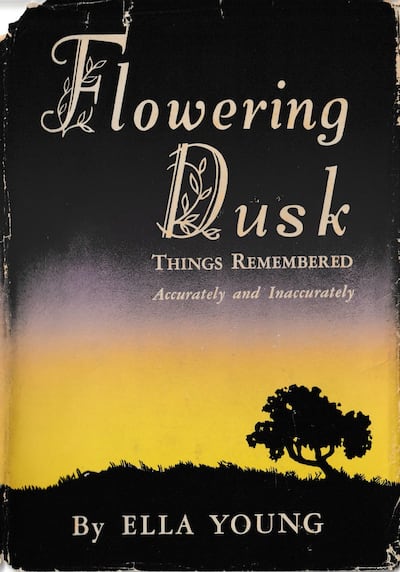In May 1931, the Colusa Herald, a California newspaper, printed a striking image of an Irish mystic dressed in a dark flowing coat and staring defiantly into the camera. Beneath the headline "Undaunted", the paper described how Ella Young, a "62-year-old Irish poetess", had finally won her right to re-enter the United States. This article and image captured a decidedly earthly interlude in the life of an Irish poet and mystic whose career was more commonly connected with the realms of ancient Irish folklore and the occult than the bureaucratic world of immigration officials.
Young was born in December 1867, in Fenagh, a townland near Ballymena, Co Antrim, the eldest of five daughters born into a Reformed Presbyterian family. The family moved to Dublin later in her childhood. Young was educated there and eventually studied for a degree in history, jurisprudence and political economy. Involvement with Irish literary types and intellectuals lead to Young befriending Maud Gonne, who provided illustrations for Young's book Celtic Wonder Tales, first published in 1910. In her memoir, Young described the home in Paris where Gonne lived with her two children as a space "with a plenitude of beautiful things" such as embroidery and rugs that were "all thrown together carelessly". Gonne also shared her home with dogs, a cat and a parrot that cursed in Spanish.
Young was close to certain California pioneers of sexual liberation, such as Elsa Gidlow, a British-born lesbian poet, and Gavin Arthur, a bisexual astrologer and sexologist
Young's immersion in Celtic mythology and theosophy fostered a spiritually-inflected Irish nationalism. Aurelia Annat notes that Young's spirituality "was the bedrock of her politics". Young was a member of Sinn Féin, which she joined in 1912, and she was also a member of Cumann na mBan from its foundation in 1914. Although she was not a participant in the Easter Rising, she was in Dublin when it took place. Helena Molony, a republican and trade unionist who met with Young the night before the Rising began, remembered that Young "was very much with us but was more of an artist". Young later recounted the Rising in her memoir, describing the whole course of events as she remembered it, from the initial confusion as trams stopped running and friends talked about rumours of telegraph wires being cut to a torrential storm of rain that greeted the city in the aftermath of the surrender.
Young was a striking and unusual figure in the social world of anti-Treaty republicanism. She particularly enjoyed attending the Dublin rooms of Kathleen O'Brennan. She described O'Brennan's home as having "a colourful strangeness, a way of reminding one of half a dozen things at once". In the mid-1920s, she travelled to the US, where she would spend the rest of her life. Her emigration, she claimed, had been foretold in 1914 by a Romani fortune teller. From 1925, she lectured on Irish Myth and Lore at the University of California, Berkeley and later became involved in the experimental communal society of the Dunites, a community of artists, mystics and other assorted bohemians living in the sand dunes of Oceano, California. Young's often mystifying worldview seemingly moved in at least one sinister direction during her life abroad: Rose Murphy noted that a friend of Young remembered her having a "strange fascination" with Hitler.

In 1945, Young published a curious autobiography titled Flowering Dusk: Things Remembered Accurately and Inaccurately. Much of Young's remembrances require readers to suspend their disbelief and inhabit her world. References to supernatural phenomena appear in the book with much the same frequency as descriptions of prominent Irish revolutionaries and fondly-remembered pets. The memoir makes clear, as Linde Lunney notes, that for Young "everyday life in Ireland or America was contiguous with the world of spirits and Celtic gods". Over the course of a page, the memoir shifts from discussing the riots that infamously greeted performances of Synge's Playboy of the Western World to giving an account of a haunted house on Baggot Street. The index contains entries for Faery-folk, Ghosts and Witches in addition to SinnFéin' and Cumann-na-mBan.
Young died in July 1956 in California. Her constellation of identities - personal, political and psychic - fascinated contemporaries and continues to draw in researchers. Recently, Young’s life has interested researchers of LGBTQ history. Aurelia Annat notes that Young was likely a lesbian and it has also been suggested that Young was in love with Maud Gonne. Young was close to certain California pioneers of sexual liberation, such as Elsa Gidlow, a British-born lesbian poet, and Gavin Arthur, a bisexual astrologer and sexologist whom Young first met in 1920s Dublin. If her spirit does live on, as she sincerely believed it would, it is through her storytelling. Some of her collections of Irish tales, many of which were written for children, have been consistently reprinted.
This Extraordinary Emigrants article was written by Dr Maurice J Casey, DFAT Historian-in-Residence at EPIC The Irish Emigration Museum in Dublin’s Docklands, an interactive museum that tells the story of how the Irish shaped and influenced the world.



















